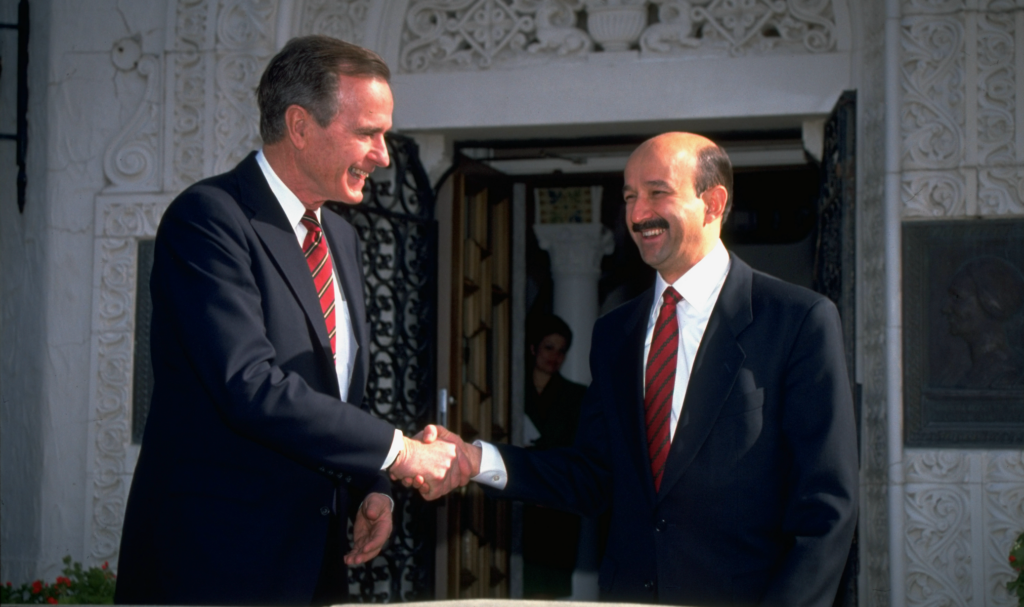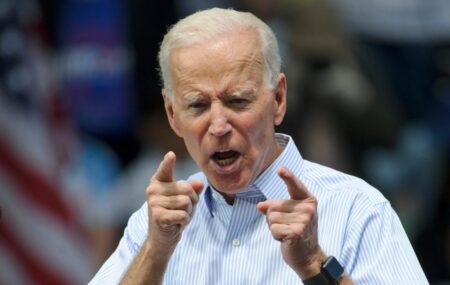NAFTA may seem like the kind of tedious policy wonkery that only a Matthew Yglesias can find fascinating, but it comes entangled with fascinating human interest stories.
There were, of course, the American workers who lost their jobs due to Ross Perot’s “giant sucking sound,” although it strikes me that the real economic disaster turned out to be America’s leadership class assuming NAFTA was less a prudent example of “continentalism” limited to our two land neighbors and more a proof that “globalism” would work with our natural archrival China, a potential industrial superpower.
And then there were the millions of Mexican peasants driven from the land where their ancestors had grown corn for 5,000 years by the first Bush administration’s insistence on maximizing the profits of Nebraska agribusiness, even though it was known that many poor peons would wind up illegally immigrating to the United States, with long-term consequences that still remain uncertain.
But I will focus instead on the family tales of three NAFTA dynasties at the absolute opposite end of the social scale: Salinas, Slim, and Bush.
Despite sharing a 1,950 mile border with the United States, Mexico is of oddly little allure to most Americans who follow the news, at least compared to, say, Israel. And yet Mexico has a population approaching 130 million, not to mention the one-seventh of American residents who trace their ancestry to Mexico. And yet, the intersection of Mexican and American history has often been luridly gripping.
Not all Americans have always been bored by Mexico. Since the 19th century, a certain class of swashbuckling American businessmen have looked to Mexico, with its vast resources and superb climates, to make their fortunes. Recent American political celebrities whose ancestors moved to Mexico to get rich have included William F. Buckley, Mitt Romney, and Bill Richardson.
A fundamental issue for Mexican political elites has always been how to get rich from being next door to the world’s most dynamic economy without becoming another banana republic dominated by American capital, like Mexico’s unprepossessing neighbors to the south. The late 19th century Mexican dictator, the quotable Porfirio Díaz, is said to have observed that Mexico was “so far from God, so close to the United States.” He eventually came around to a policy of “defensive modernization,” opening Mexico to American railroad builders.
An exultant 1910 New York Times book review of a hagiographic biography of the aged Porfirio Díaz quoted countless American eminences such as Andrew Carnegie and Elihu Root praising the dictator as a genius for seeing the light and swinging wide the gates of his nation to American business, bringing no doubt everlasting prosperity. The Times reviewer summed up:
PORFIRIO DIAZ, President of the Mexican Republic, should be a very happy man, for he not only enjoys the ardent admiration of the civilized world but knows he has fairly earned it. No public servant ever had more perfect reward than his, and no public servant ever was more deserving. It would be hard to exaggerate his deserts, so great and wonderful have been the results of his life’s work for his country.
Later that year, the cataclysmic Mexican Revolution broke out that killed at least one million people, and Porfirio Díaz was soon in exile in Paris. Sounding like a proto-Yogi Berra, he observed, “Nothing ever happens in Mexico, until it happens.”
In the late 1920s, the winners of the revolution tired of assassinating each other and, led by Plutarco Elías Calles, devised a rather clever form of government. The surviving revolutionaries would unite in a ruling party with the oxymoronic title of the Institutional Revolutionary Party (PRI). The president would have dictatorial power but with one absolute limitation: he’d serve only a single six-year term.
So there was no longer much need to shoot presidents. If you lived long enough, your faction within the PRI would come to power and cut you in on the loot.
Mexico in the mid-20th Century was even fairly democratic: all else being equal, the PRI preferred to win the most votes, and would distribute largesse widely from its cash cows, such as its oil company Pemex, to do it.
The great economic prize in Mexico was always its ample oil reserves. In 1938, the most popular president of the century, the leftist Lázaro Cárdenas, nationalized foreign oil companies (eventually paying compensation) and established the Pemex monopoly.
After WWII, young Yale man George H. W. Bush’s eyes turned south, nominally toward the oilfields of Texas. But his ambitions came to center on Mexico. He and his partners formed the Zapata Petroleum Corporation, naming it after the most heroic of the Mexican revolutionaries. (A generation later, George W. Bush also gave his Texas oil company a Spanish name, Arbusto.)
Eventually they broke up, with Bush’s partners turning the domestic business into lucrative Pennzoil, while Bush concentrated on offshore oil drilling in Mexico. (There exists a conspiracy theory that Bush’s oil platforms provided logistical support to the CIA’s Bay of Pigs invasion of nearby Cuba. But this is one of those conspiracy theories that sounds so reasonable—why wouldn’t a Skull & Bones man help out his friends in the Company?—that nobody finds it intriguing.)
Pemex lacked the skills to drill in the Gulf of Mexico, but Bush was banned by the Mexican constitution from operating in Mexico. So he hired as his front man Jorge Diaz Serrano, who later rose up to head Pemex and be talked of as the 1982 PRI presidential candidate. Instead, Bush’s friend was sent to prison by the new president as the designated fall guy for all the corruption during Mexico’s 1970s oil boom.
But something unexpected happened as the senior Bush’s ambitions evolved from business to politics. In 1970, George’s most promising son, Jeb, went on a semester abroad from Andover to Mexico, where he met a señorita and fell forever in love. This was not, as you might expect, an arranged marriage between American and Mexican elites, but a fortuitous romance between an American princeling and a farmer’s daughter. Jeb and Columba married in 1974 and had three kids.
Their darkest-skinned son, George P. Bush, had the best personality for politics. His grandfather made sure to feature his “little brown one” (as Bush once referred to him) at the 1988 Republican convention leading the pledge of allegiance. This sounds inane but was actually a major moment because the elder Bush had chosen to make an important campaign issue out of Michael Dukakis vetoing a bill mandating the pledge of allegiance in Massachusetts schools.
Over time, young George P. emerged in the Bush dynasty’s thinking as their designated third generation president, after George, then either Jeb or George W. (or both), followed in the fullness of time by George P. as the first Mexican-American president of a Latinoizing republic. In the White House in the 2000s, George W. referred to his father as “41” (being the 41st President), himself as “43,” and his high potential nephew George P. as “44.”
It’s over the top to say that George H. W.’s signature policy of NAFTA and George W.’s signature policy of amnesty for illegal immigrants were precisely intended to increase the number of Mexicans who would be eligible to vote for George P. Then again, the mood music all kind of fit together.
Meanwhile, in Mexico in the 1980s, the Salinas brothers were moving closer to the presidency that their father had almost achieved. When technocrat Carlos Salinas was tapped to be the next PRI president in 1988, he told his father, who had been passed over for the presidency in 1964, “It took us more than 20 years, but we made it.”
Yet, the candidate of the leftist coalition, Cuauhtémoc Cárdenas, son of the man who nationalized the oil business 50 years earlier, took the lead in the early vote counting. Would the PRI lose for the first time ever?
Suddenly, it was announced to the TV audience that “the system crashed.” When the computer was finally turned back on, Salinas was declared the winner.
After this inauspicious start, the new president installed his brother Raúl, in the time-honored Mexican tradition, as Mr. Ten Percent who took a tithe on all government deals.
And Salinas looked for a policy. With the Cold War winding down, Salinas became worried that American focus would turn toward newly capitalist Eastern Europe. So they campaigned to get Mexico added to NAFTA, which had started out as an uncontroversial trade pact between America and similar Canada. With Communism collapsing, the Salinas brothers further got into the spirit of the age by cheaply selling off most of Mexico’s government monopolies to PRI oligarchs, such as Carlos Slim, who bought Telmex.
For several years, things seemed to be going well. The economy prospered as, perhaps coincidentally, cocaine barons like Pablo Escobar were hunted down in Colombia and Mexico became the prime transshipment point in the Western Hemisphere drug trade.
Relations with America flourished. Jeb and Columba Bush vacationed several times at the ranch of Raúl Salinas. In 1990, at his sixth meeting with Salinas, President Bush orated:
Both of us are the sons of senators. Both of us were raised to believe in public service and both of us know what is true for two people is true for two nations. Friendship makes us stronger. I know that my country is also stronger because of Mexico’s contribution to our cultural heritage—a rich bequest: architecture, language, and culture. And in a more personal way is the heritage bestowed on the Bush family. Our son Jeb has lived in your country, his wife Colomba was born in your country… and their union has given Barbara and me three beloved grandchildren. So when I speak of Americans and Mexicans I can only say, somos una familia, we are one family.
In February 1993, Salinas invited 30 oligarchs to a billionaire’s banquet at the presidential mansion. He asked them to contribute 25 million each to the PRI’s 1994 campaign.
“Pesos or dollars?” one gulped.
“Dollars.”
Slim spoke up to say, sure, he’d toss in 25 million dollars, but then he judiciously suggested it would have been better if the cash had been demanded privately to avoid unfortunate publicity.
But then weird stuff started happening in Mexico. In late 1993, a cardinal who was emerging as a critic of the connection between the regime and the drug cartels was shot down at the Guadalajara airport. The Salinas government announced implausibly that sicarios gunning for El Chapo had tragically mistaken Cardinal Posadas for the notorious cartel leader.
In March 1994, the PRI candidate Luis Donaldo Colosio, after weeks of rumors that he was quarreling with his mentor Salinas, was assassinated in Tijuana.
And in September 1994, the head of the PRI, José Ruiz Massieu, the former brother-in-law of the Salinas brothers, was murdered. The victim’s own brother was put in charge of the investigation, but he was eventually arrested in Newark, NJ, attempting to flee to Spain with $17 million in his bank account.
Raúl Salinas was convicted of orchestrating the murder of his ex-brother-in-law and sentenced to 27 years in prison. He was let out after eight. Carlos Salinas went into exile in Ireland for a number of years. In 2004, a third Salinas brother, Enrique, was found strangled with a plastic bag over his head.
In contrast, the Slim family flourished, with the telecom monopolist heading the global Forbes 400 as the richest man in the world in 2010-2013, a remarkable feat for a Mexican. He got particularly wealthy off charging exorbitant fees for phone calls between illegal aliens in America and their loved ones in Mexico.
Criticism of Slim in the American press tailed off after he financially rescued the ailing New York Times in 2009 with a $200 million infusion. After Slim’s bailout, the influential newspaper, which had editorialized against amnesty as recently as 2000, became more virulently hostile toward immigration skeptics.
In 2015, the first biography of Slim was published. Fleet Street found fascinating the revelation that Slim, a Maronite Catholic of Lebanese ancestry, had married into the most notorious right-wing warlord dynasty in Lebanon. His wife, Soumaya Domit Gemayel, was the granddaughter of the founder of the Phalanges paramililitary. Pierre Gemayel had been inspired by his 1936 visit to Hitler’s Berlin Olympics to found a political party named after Spain’s fascists.
Pierre’s son Bashir Gemayel is considered the most controversial figure in Lebanese history for collaborating with Ariel Sharon in Israel’s 1982 invasion of Lebanon. During the war, shortly after being elected president, he was blown up by a fellow Maronite. But Gemayel’s supporters assumed his enemies in the Palestine Liberation Organization were responsible and massacred hundreds or thousands of Palestinians in the Sabra and Shatila refugee camps.
Gemayel’s obituary in the New York Times had been memorably headlined:
Bashir Gemayel Lived By the Sword
In the United States, however, the press in 2015 took its lead from the grateful New York Times and decided that this human interest story related to Slim, the recent world’s richest man and savior of the Times, was news not fit to print.
The Bush dynasty’s story appears at present to be ending quietly. George P. Bush, a modest man, plotted out a methodical rise through Texas politics for himself, with first eight years as the state’s land commissioner from 2015-2023, then attorney general, then governor, finally setting himself up to run for president around age 60 in 2036.
George P. was the only member of the Bush clan to stay on friendly terms with Donald Trump. But when he ran for attorney general in the 2022 GOP primary, the magic of the Bush name had worn off and he lost badly.
So, the Grand Strategy of the Bush Dynasty going back to the elder Bush’s illegal oil operations in Mexico c. 1960 to open the country to American business in return for opening America to Mexican immigrants appears to have fizzled out.
Then again, almost nobody ever noticed that was what the Bushes were contemplating while they were trying to pull it off. Thus, the future remains unwritten.
Read the full article here












